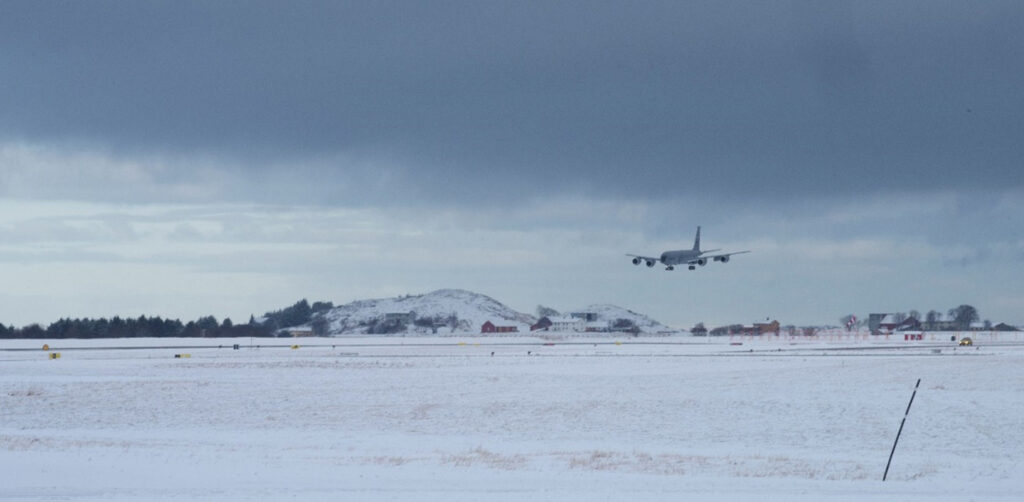THE WATCH STAFF
A U.S. Air Force KC-135R Stratotanker arrives at Ørland Air Station, Norway, in 2020. Norway is reexamining its defense strategy toward Russia after its eastern neighbor’s invasion of Ukraine last year.
Russia’s invasion of Ukraine has senior Norwegian military officials reexamining their country’s defense strategy toward its aggressive neighbor.
Self-imposed Norwegian restrictions of military flight activity near the country’s border with Russia should be phased out, a Norwegian general said.
According to Lt. Gen. Rune Jakobsen, former commander of the Norwegian Joint Headquarters, stated in the Norwegian newspaper VG in August 2023, “We need a totally new Russia strategy. My advice is for Norway to scrap both the base policy and self-imposed restrictions.”
“We need to send stronger signals to Russia to avoid being exposed to hybrid operations in an area where we are very vulnerable.”
In restrictions dating back to the Cold War, NATO allies don’t fly east of Porsanger Fjord in eastern Norway to gather intelligence on Russia. Farther east, starting at Tana Fjord, only Norwegian warplanes can operate, according to the Barents Observer website.
The regulations were put in place to avoid conflict with the Soviet Union, which based its fleet of nuclear submarines on the nearby Kola Peninsula where they remain to this day.
Russia hasn’t reciprocated with its own flight restrictions and has conducted mock attacks against Norway, a Norwegian defense analyst told the news site. Since Russia’s 2022 invasion of Ukraine, the national security calculus has shifted, said Per Erik Solli with the Norwegian Institute of International Affairs.
“Given the current state of affairs, the most important issue is not to restrict allied military activity near Russia, but to ensure that the Russian military stay on their side of the border,” Solli told the Barents Observer.
The proposal comes after recent Swedish and United States surveillance flights over Russia traversed Finland’s airspace, avoiding Norway.
A Swedish Gulfstream S102B Korpen electronic intelligence plane flew along the Finnish border, circling several times just west of the Russian border on August 22, according to the Barents Observer.
The same day, a U.S. Air Force RC135V/W Rivet Joint surveillance aircraft collected Russian signals from international air space over the Barents Sea, the news site reported.
Neither plane entered Norwegian air space.
The Barents Observer in March 2023 reported that this is a significant event because it is the first time that Finland opened its skies to the RC-135, a U.S. surveillance airplane, in advance of becoming a NATO member in April 2023.
While Norway reevaluates its restrictions on intelligence-gathering flights, the head of its Air Force told the High North News that the country should consider establishing an Arctic Air Operations Center in northern Norway.
Maj. Gen. Rolf Folland, the Air Force chief, told the newspaper that the move would be a “game changer.”
“Norway is NATO in the north. It is natural that we have taken the initiative to take the process further, from the Nordic to the Arctic scale. In such a format, it would be natural to include representatives from close allies — who have Arctic interests such as the U.S., the U.K., and Canada’s Air Force,” Folland told the newspaper.
Folland aired the proposal on August 15 as his workplace moved 850 kilometers north from Rygge, south of Oslo, to Bodø in northern Norway, the site of the Norwegian Air Operations Centre and the Norwegian Joint Headquarters (NJHQ). The NJHQ takes the lead in operational planning and management for the country’s armed forces.
The location of an Arctic Air Operations Center hasn’t been determined, but closer collaboration with other Nordic nations is underway.
Denmark, Finland, Norway and Sweden agreed this year to explore a joint Nordic air defense to integrate some aspects of their operations such as air stations, training and education, maintenance, and logistics while maintaining separate air forces.
“The ambition is that we will be able to operate as a unit during the Nordic Response 2024 exercise and that we will be able to test the Nordic air operations center,” Folland told the High North News.
Plans for the operation center should firm up by the end of the year, Folland said.

